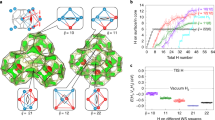Abstract
Molecular dynamic simulations of helium atoms escaping from a helium-filled nanobubble near the surface of crystalline palladium reveal unexpected behavior. Significant deformation and cracking near the helium bubble occur initially, and then a channel forms between the bubble and the surface, providing a pathway for helium atoms to propagate toward the surface. The helium atoms erupt from the bubble in an instantaneous and volcano-like process, which leads to surface deformation consisting of cavity formation on the surface, along with modification and atomic rearrangement at the periphery of the cavity. The present simulation results show that, near the palladium surface, there is a helium-bubble-free zone, or denuded zone, with a typical thickness of about 3.0 nm. Combined with experimental measurements and continuum-scale evolutionary model predictions, the present atomic simulations demonstrate that the thickness of the denuded zone, which contains a low concentration of helium atoms, is somewhat larger than the diameter of the helium bubbles in the metal tritide. Furthermore, a relationship between the tensile strength and thickness of metal film is also determined.






Similar content being viewed by others
References
J.N. Yu, X.J. Zhao, W. Zhang, W. Yang, and F.M. Chu: Defect production and accumulation under hydrogen and helium ion irradiation. J. Nucl. Mater. 251, 150 (1997).
L. Yang, X.T. Zu, H.Y. Xiao, F. Gao, H.L. Heinisch, R J. Kurtz, and K.Z. Liu: Atomistic simulation of helium-defect interaction in alpha-iron. Appl. Phys. Lett. 88, 091915 (2006).
J.H. Evans, A. van Veen, and L.M. Caspers: Formation of helium platelets in Molybdenum. Nature 291, 310 (1981).
P.B. Johnson and D.J. Mazey: Helium gas bubble lattices in face-centred-cubic metals. Nature 276, 595 (1978).
R. Vassen, H. Trinkaus, and P. Jung: Helium desorption from Fe and V by atomic diffusion and bubble migration. Phys. Rev. B 44, 4206 (1991).
R.S. Barnes: Embrittlement of stainless steels and nickel-based alloys at high temperature induced by neutron radiation. Nature 206, 1307 (1965).
R. Lasser: Tritium and Helium-3 in Metals (Springer-Verlag, Berlin, 1989).
G.C. Abell, L.K. Matson, and R.H. Steinmeyer: Helium release from aged palladium tritide. Phys. Rev. B 41, 1220 (1990).
D.B. Porker and J.M. Williams: Low-temperature release of ion-implanted helium from nickel. Appl. Phys. Lett. 40, 851 (1982).
D.J. Mitchell and J.L. Provo: Irregularities in helium release rates from metal ditritides. J. Appl. Phys. 57, 1855 (1985).
C.S. Snow and L.N. Brewer: Helium release and microstructural changes in Er(D, T)2_ x3He x films. J. Nucl. Mater. 374,147 (2008).
D.E. Peterson, J.W. Early, J.S. Starzynski, and C.C. Land: Helium Release from Radioisotopic Heat Sources, Los Alamos Scientific Laboratory Report No. LA-10023 (Los Alamos, NM, 1984).
K.L. Shanahan and J.S. Holder: Helium release behavior of aged titanium tritides. J. Alloys Compd. 404–406, 365 (2005).
W.G. Wolfer: The pressure for dislocation loop punching by a single bubble. Philos. Mag. A 58, 285 (1988).
W.G. Wolfer: Dislocation loop punching in bubble arrays. Philos. Mag. A 59, 87 (1989).
R.C. Bowman and A. Attalla: NMR studies of the helium distribution in uranium tritide. Phys. Rev. B 16, 1828 (1977).
W.J. Camp: Helium detrapping and release from metal tritides. J. Vac. Sci. Technol. 14, 514 (1977).
T. Schober, H. Trinkaus, and R.A. Lasser: A TEM study of the aging of Zr tritides. J. Nucl. Mater. 141–143, 453 (1986).
D.F. Cowgill: Helium nano-bubble evolution in aging metal tritides. Fusion Sci. Technol. 48, 539 (2005).
S. Thiebaut, M. Douilly, S. Contreras, B. Limacher, V. Paul-Boncour, B. Decamps, and A. Percheron: He retention in LaNi5 and Pd tritides: Dependence on stoichiometry, He distribution and aging effects. J. Alloys Compd. 446–447, 660 (2007).
J.A. Emig, R.G. Garza, L.D. Christensen, P.R. Coronado, and P.C. Souers: Helium release from 19-year-old palladium tritide. J. Nucl. Mater. 187, 209 (1992).
W.Y. Hu: Proceedings of the International Conference on New Frontiers of Process Science and Engineering in Advanced Materials, 14th IKETANI Conference, edited by M. Naka and T. Yamane and (Osaka University, Osaka, Japan, 2004), p. 7.
S.F. Xiao, W.Y. Hu, and J.Y. Yang: Melting behaviors of nano-crystalline. Ag. J. Phys. Chem. B 109, 20339 (2005).
S.F. Xiao and W.Y. Hu: Comparative study of microstructural evolution during melting and crystallization. J. Chem. Phys. 125, 014503 (2006).
M.I. Baskes and C.F. Melius: Pair potentials for fee metals. Phys. Rev. B2Q, 3197 (1979).
R.A. Johnson: Empirical potentials and their use in the calculation of energies of point defects in metals. J. Phys. F: Met. Phys. 3, 295 (1973).
C.B. Barber, D.P. Dobkin, and H. Huhdanpaa: The Quickhull algorithm for convex hulls. ACM Trans. Math. Softw. 22, 469 (1996).
A.E. Selyutin: Determination of the ultimate load for breaking membranes. Problemy Prochnosti. 11, 119 (1985).
M.P. Allen and D.J. Tidesley: Computer Simulation of Liquids (Oxford Science Publications, Oxford, 1987).
University of Virginia, MSE 524, Modeling in Materials Science. (Leonid Zhigilei, Spring, 2003).
M. Cerny and J. Pokluda: Influence of superimposed biaxial stress on the tensile strength of perfect crystals from first principles. Phys. Rev. B 76, 024115 (2007).
Author information
Authors and Affiliations
Corresponding author
Rights and permissions
About this article
Cite this article
Wang, L., Hu, W., Deng, H. et al. Helium nanobubble release from Pd surface: An atomic simulation. Journal of Materials Research 26, 416–423 (2011). https://doi.org/10.1557/jmr.2010.49
Received:
Accepted:
Published:
Issue Date:
DOI: https://doi.org/10.1557/jmr.2010.49




